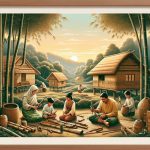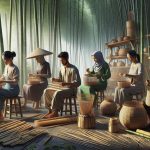In the Philippines, bamboo isn't just a plant; it's a vital part of the culture and economy. The country boasts around 20 unique bamboo species, each adapted for different uses, from construction to crafting traditional musical instruments. It's quick-growing, making it a sustainable choice, and it plays a crucial role in building classic Filipino houses like the Bahay Kubo. Economically, bamboo supports steady income through various products and helps in environmental efforts like soil erosion control and carbon sequestration. It's fascinating how this single plant impacts so many aspects of life here, and there's still more to discover about its benefits!
Table of Contents
Key Takeaways
- Bamboo in the Philippines comprises around 20 unique species, each with distinct uses and properties.
- It is a sustainable resource, growing quickly and used in various engineered products.
- Historically, bamboo has been essential in traditional Filipino homes, tools, weapons, and cultural practices.
- Bamboo farming supports the Philippine economy, offering steady income and boosting exports.
- The plant plays a crucial ecological role, enhancing biodiversity, controlling soil erosion, and sequestering carbon.
Bamboo Species in the Philippines
The Philippines boasts around 20 unique bamboo species, highlighting its diverse ecosystem. Isn't it cool how these native bamboos not only thrive but also play crucial roles in both the environment and economy? Each species has its own unique traits, making them suitable for various uses, though I won't get into the historical uses here.
Now, you might wonder why bamboo's such a big deal there. It's simple. These bamboos grow incredibly fast. Imagine planting one and seeing it ready for harvest in just three years! This rapid growth cycle makes bamboo a star in sustainable resource circles. Plus, it's not just about the raw bamboo. The Philippines has gotten pretty innovative, transforming these bamboos into engineered products like robust construction materials and sleek floor and wall panels.
Beyond just looking at their practical applications, these bamboo species are a testament to the Philippines' rich biodiversity. They contribute significantly to ecological balance and are integral to various habitats. Each species, with its distinct characteristics, supports a wide range of wildlife and underpins local communities by providing both materials and jobs. It's a full circle of benefits, all sprouting from these remarkable bamboo species.
Historical Uses of Bamboo
As we look back, it's clear that bamboo has been super important in Philippine history. It's been used for everything from building homes to making tools and weapons.
We'll also see how it played a key role in cultural traditions and rituals across the country.
Traditional Housing Structures
Bamboo has long been a cornerstone in building traditional Filipino homes, known locally as Bahay Kubo. It's not just about the charm or the low costs—bamboo is deeply practical. It resists erosion brilliantly, which is crucial in the Philippines where heavy rains and typhoons are frequent. These houses aren't just quaint relics; they're a masterclass in sustainable architecture, utilizing local materials to create structures that breathe and flex with the environment.
Every part of a Bahay Kubo has bamboo – from the sturdy flooring to the woven walls and thatched roofing. This widespread use underlines bamboo's role in the structural integrity and cultural identity of traditional Filipino communities. It's truly the backbone of rural architecture here.
Crafting Tools and Weapons
Moving beyond housing, I'll now explore how bamboo was also key in making tools and weapons throughout Philippine history. Filipinos have long relied on this sturdy yet flexible material for crafting tools crucial for survival and daily life.
Imagine villagers fashioning bamboo into sharp knives, durable spears, and even precise arrowheads. Not just that, bamboo came in handy for making blowguns, effective traps, and essential fishing tools, all integral to indigenous hunting practices.
Moreover, our ancestors were quite ingenious, using bamboo to create not just simple tools but also traditional weapons like swords and shields, and agricultural implements such as diggers and sickles. This versatility truly cements bamboo's role in our cultural heritage as a fundamental resource.
Cultural and Ritual Significance
Beyond its practical uses, I've discovered that bamboo holds deep cultural and ritual significance in Filipino traditions. Here's how it weaves into the cultural fabric:
- Traditional Homes: Bamboo's strength and flexibility made it ideal for constructing traditional Filipino houses, blending seamlessly with the natural environment.
- Musical Instruments: From the soothing sounds of bamboo flutes to the rhythmic beats of bamboo drums, these instruments are central to Filipino musical heritage.
- Ritual Dances: Bamboo poles aren't just props; they're integral to dances like Tinikling, symbolizing agility and community spirit.
- Ceremonial Tools: In rituals, bamboo is used in various forms, from containers to ceremonial weapons, each adding a layer of cultural depth.
This versatile plant truly is a cornerstone of Filipino cultural identity.
Bamboo's Role in Ecosystems
Bamboo's not just a plant, it's a powerhouse in maintaining our ecosystems. It ramps up biodiversity, holds the soil tight to prevent erosion, and sucks up carbon dioxide like a pro.
Let's chat about how these features make bamboo a hero in our fight against environmental issues.
Bamboo Biodiversity Enhancement
Bamboo significantly boosts biodiversity by offering shelter and nourishment to a variety of species within ecosystems. It's really fascinating how much life these tall, slender bamboo poles can support. Here's a quick peek at what's happening around these poles:
- Birds: They love nesting in the dense canopy.
- Insects: The thick underbrush provides a buzzing haven.
- Mammals: Small critters find bamboo thickets perfect for hiding.
- Reptiles: Snakes and lizards thrive in the leafy moisture.
Each of these creatures plays a part in the rich tapestry of the ecosystem, maintaining balance and promoting a healthy environment. It's a bustling world in there, all thanks to the humble bamboo!
Soil Erosion Control
I've discovered that the extensive root system of bamboo is incredibly effective at controlling soil erosion. This is especially true for giant bamboo, which has a robust and dense network of roots that grips the soil tightly, preventing it from washing away during heavy rains.
On steep slopes where the risk of land degradation is high, this plant is a game-changer. It not only holds the topsoil in place but also helps retain soil moisture, reducing surface runoff significantly.
Carbon Sequestration Capabilities
In addition to preventing soil erosion, bamboo also plays a significant role in absorbing carbon dioxide from the atmosphere. Here's how it's making a big impact:
- Massive Absorber: Imagine fields of bamboo soaking up to 12 tons of carbon dioxide per hectare every year. That's like removing thousands of cars off the road annually!
- Rapid Grower: Bamboo shoots up quickly, capturing carbon fast and efficiently, which is crucial for timely climate action.
- Ecosystem Reviver: It transforms degraded lands into thriving habitats, increasing biodiversity and further aiding carbon capture.
- Sustainable Champion: By integrating bamboo into land management, we're not just cutting down on carbon dioxide; we're also promoting sustainable practices and improving air quality.
Economic Impact of Bamboo
How does bamboo significantly boost the Philippine economy? Well, let's dive into its economic impact.
Bamboo isn't just another plant; it's a powerhouse in the Philippine economy, growing rapidly and ready for harvest in just 3 to 5 years. This quick turnaround means continuous production and a steady income for farmers and businesses involved.
The real magic of bamboo lies in its versatility. From construction and furniture to even food products, bamboo is everywhere. Each of these uses contributes significantly to the economic landscape, providing jobs and sustaining industries. Think about the houses, chairs, or even the bamboo shoots you find in your local market—all of these are everyday reminders of how bamboo supports various sectors.
Moreover, bamboo's potential isn't limited to local consumption. It's a hot commodity in international markets, offering a valuable source of export income. By developing and exporting new bamboo products, the Philippines can tap into global markets, boosting its economic stature further.
And let's not overlook the local communities. Bamboo propagation creates numerous localized economic opportunities, uplifting not just the economy but also the lives of many Filipinos. It's clear that bamboo does more than just grow; it thrives and lets thrive, making it a key player in the Philippine economy.
Sustainable Bamboo Farming Practices
Let's now explore how the Philippines harnesses sustainable bamboo farming practices to maintain its economic and environmental health. By focusing on native species like Bayog and Guadua, these practices aren't just about growing plants; they're about caring for the future.
Here's what makes these practices shine:
- Ecological Balance: By planting bamboo, farmers help maintain the natural biodiversity. Bamboo acts as a sanctuary for various wildlife, supporting a balanced ecosystem.
- Soil Conservation: The robust root systems of bamboo help in preventing soil erosion significantly. This is vital for maintaining fertile land and preventing landslides, especially in the Philippines' varied terrains.
- Carbon Sequestration: Bamboo absorbs carbon dioxide at a high rate, which makes it a champion in the fight against climate change. This not only cleans the air but also provides cleaner, healthier surroundings.
- Organic Practices: Farmers employ organic methods that avoid harmful chemicals. This includes natural pest controls and using compost as fertilizer, which keeps the soil healthy and productive for future generations.
Bamboo in Filipino Culture
Bamboo deeply shapes everyday life in the Philippines, serving as both a material and cultural cornerstone. I've seen it everywhere, from the traditional Bahay Kubo houses in my village to the sturdy furniture in our homes. It's not just about using bamboo because it's abundant and cheap; it's about a connection to our heritage and a nod to sustainable living.
In the countryside, bamboo is vital. We use it in farming for tools and in the kitchen for crafting utensils that last a surprisingly long time. But it's not all work with bamboo. It also plays a huge role in our fun and festivities. Have you ever heard bamboo music? Instruments like flutes and gongs crafted from bamboo are central to Filipino cultural performances, creating sounds that are unmistakably ours.
Then there's the Tinikling dance – it's something else! It involves dancers nimbly jumping between clapping bamboo poles. It's not just entertainment; it's a celebration of skill, timing, and the bamboo itself. This dance, like many aspects of our culture, highlights the versatility and cultural significance of bamboo in our lives. It's truly woven into the fabric of Filipino identity.
Technological Innovations With Bamboo
In the Philippines, we're turning to bamboo for groundbreaking sustainable construction technologies. It's not just about using what we've got; it's about pushing boundaries, innovating, and creating something truly resilient and eco-friendly. This isn't your traditional use of a native plant—bamboo, though often considered an introduced species, has found a significant role in our architectural landscape.
Here's how we're doing it:
- Engineered Bamboo Products: We're transforming bamboo into high-performance structural components. Think beams, columns, and even trusses that rival the strength and durability of traditional materials.
- Bamboo Flooring and Wall Panels: It's not just about structural integrity. Aesthetics matter too, and bamboo provides a stunning, versatile option for both flooring and decorative wall panels that are as tough as they're beautiful.
- Eco-Friendly Construction Solutions: By incorporating bamboo, we're reducing our carbon footprint. It's a renewable resource that regenerates quickly, making it a superstar in sustainable construction.
- Resilient Building Designs: With its natural flexibility and strength, bamboo is perfect for creating buildings that can withstand the rigors of natural disasters—crucial in a country prone to typhoons and earthquakes.
Bamboo is redefining what it means to build sustainably in the Philippines.
Bamboo Crafts and Products
While we've explored bamboo in construction, it also stars in a variety of crafts and everyday products. In the Philippines, this versatile plant isn't just about planting bamboo; it's woven into the very fabric of daily life and culture. Artisans here have perfected the art of bamboo crafts, creating everything from intricate baskets and mats to durable furniture. These items aren't just practical; they're works of art that showcase the intricate weaving techniques passed down through generations.
Traditional bamboo products like fans, hats, and musical instruments aren't just souvenirs. They're integral to Filipino cultural expressions, used in dances, festivals, and daily life. The craftsmanship involved is incredible, reflecting a deep respect for this sustainable resource.
Moreover, bamboo's role in modern eco-friendly products like utensils, straws, and home decor has grown significantly. These items represent a shift towards sustainability, tapping into bamboo's potential to reduce environmental impact. You'll also find bamboo in decorative forms—lanterns, wind chimes, and wall hangings that add a touch of nature to any space.
Bamboo crafts and products in the Philippines are a testament to the plant's versatility and the artisans' skill—truly, bamboo is much more than just a plant here.
Policies Affecting Bamboo Cultivation
Government policies play a crucial role in shaping the cultivation and sustainability of bamboo in the Philippines. It's clear that without government support, the potential of bamboo as a significant economic and environmental asset might never be fully realized. So, what's being done? Well, a lot, actually.
Here's a quick rundown:
- National Greening Program: This initiative has been a game changer, planting bamboo across over 19,000 hectares nationwide. It's a massive push towards not only greening the environment but also boosting the bamboo sector.
- Partnerships with Organizations: The government is collaborating with international bodies like INBAR to promote bamboo as a tool for poverty alleviation. This partnership is crucial for both knowledge sharing and practical implementation.
- Enhancing the Value Chain: The Department of Trade and Industry is on board too. They're aligning their programs to reinforce the entire bamboo industry value chain from cultivation to marketing.
- Unified Program for Export: A unified approach is being developed to position bamboo as an export champion. This strategy supports not just the economic angle but also social enterprises that can benefit from bamboo production.
Each of these efforts shows how seriously the government is taking bamboo cultivation. It's not just about planting trees; it's about nurturing an industry.
Future of Bamboo in the Philippines
Looking ahead, the future of bamboo in the Philippines seems packed with potential.
From sustainable development initiatives that bolster eco-friendly projects to the economic growth opportunities that create jobs and boost local economies, there's a lot to be excited about.
Plus, the added bonus of reducing ecological impacts makes investing in bamboo even more appealing.
Sustainable Development Initiatives
In the Philippines, the bamboo industry's growth is ramping up efforts toward sustainable development and environmental preservation. Here's how this versatile bamboo plant is making a significant impact:
- Reforestation Initiatives: Planting bamboo in deforested areas helps restore soil stability and increases carbon sequestration.
- Erosion Control: The robust root system of bamboo plants significantly reduces erosion, protecting landscapes and water sources.
- Bioenergy Production: Using bamboo as a renewable energy source reduces reliance on fossil fuels.
- Biodiversity Enhancement: Bamboo forests support diverse wildlife, promoting ecological balance.
I'm excited to see how these initiatives not only preserve our environment but also pave the way for a greener future in our country.
Economic Growth Opportunities
While we're boosting our environmental efforts with bamboo, it's also opening up exciting economic growth opportunities across the Philippines. This booming industry isn't just about producing more bamboo; it's about sparking widespread economic benefits.
By diving into bamboo cultivation, we're creating numerous job opportunities, especially in rural areas where they're needed most. This isn't just about planting and harvesting; it's about innovating. Developing new bamboo products expands our market reach both locally and globally, pushing our economic growth even further.
Plus, with government initiatives supporting this green shift, the entire sector is getting a hefty boost. It's clear: bamboo's role in the Philippines stretches beyond the environment—it's a key player in our economic strategy too.
Ecological Impact Reduction
Bamboo cultivation is drastically cutting down our country's ecological footprint by enhancing carbon capture and controlling soil erosion. Here's how it's making a real impact:
- Carbon Warrior: Each bamboo plant acts like a giant sponge, soaking up carbon dioxide and releasing fresh oxygen back into our atmosphere.
- Soil Guardian: The root systems hold the soil firmly, preventing erosion especially during heavy rains.
- Water Reviver: Plantations near rivers help purify the water, reducing pollution runoff and maintaining natural habitats.
- Green Fast-Track: With its swift growth, bamboo is a champion in afforestation efforts, quickly turning barren lands green and boosting biodiversity.
It's clear, bamboo's not just a plant, it's a powerhouse in our fight for a sustainable future.
Frequently Asked Questions
What Is Bamboo Known for in the Philippines?
In the Philippines, bamboo's famous for its rapid growth and versatility. It's used in building homes, making furniture, and various tools, while also helping with soil conservation and carbon sequestration.
Is Bamboo Expensive in the Philippines?
Bamboo isn't expensive in the Philippines; it grows quickly and is plentiful. Its affordability makes it a go-to for construction and more, thanks to local availability and easy cultivation.
What Is the Symbol of Filipino Bamboo?
The symbol of Filipino bamboo showcases resilience, strength, and versatility. It's deeply rooted in our culture, representing adaptability and sustainable growth, vital in various aspects of our traditions and daily life.
What Is Philippine Bamboo Month?
Philippine Bamboo Month, celebrated every September, promotes awareness and sustainable practices for bamboo. It includes planting, workshops, and exhibits, emphasizing bamboo's cultural, economic, and environmental significance in various industries.
- Why Open-Weave Scrim Is the Secret to Stunning Event and Canopy Designs - June 26, 2025
- Creating Large-Scale Art Installations With Scrim Fabric - June 26, 2025
- Scrim Fabric in Upholstery: Understanding Its Use as a Backing Material - June 26, 2025







